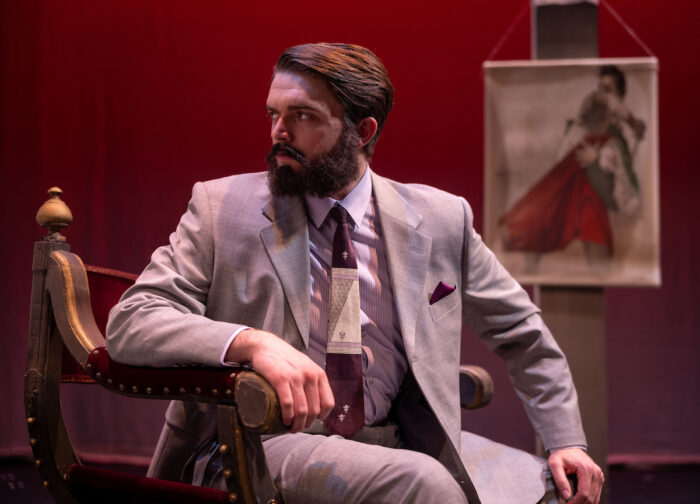PROVO — After a crowd of senators has stabbed Julius Caesar to death, Cassius asks, “How many ages hence shall this our lofty scene be acted over in states unborn and accents yet unknown?” As he wrote those lines, did Shakespeare somehow know that his play Julius Caesar would still be performed in America four centuries after his death? And did Shakespeare know that there would be a production of Julius Caesar as wonderful and satisfying as the one on stage now at BYU?

Show closes December 4, 2021.
Julius Caesar is Shakespeare’s famous retelling of the death of the play’s title character and the civil war that it sparks in the ancient Roman Empire. Despite the play’s name, its main characters are Cassius and Brutus. According to Shakespeare, Cassius hatches the plot to assassinate Caesar, and Brutus needs to be persuaded. Once Brutus joins the conspiracy, though, he is fully committed to betray Caesar and ride the political consequences as they unfold.
The play is magnificently directed by Linda Hartzell, and almost every scene is entrancing. Hartzell gradually ratchets up the tension in the first half of the play, culminating in an assassination scene that is equally engrossing and terrifying. The second half of the play transitions from politics to war, and Hartzell handles this change smoothly. The action moves quickly, though Hartzell does appreciate the quiet moments that the characters experience in the midst of turbulent events. Hartzell was astute in taking a moment to allow Brutus to mourn over his newly deceased wife, or to give Cassius time to ponder the possibility of losing the war. These scenes provided a lovely contrast that made the characters human, and not distant historical figures.

Background, left to right: Sadie Veach as Cassius, Juniper Taylor as Antony, and Skyler Denfeld as Brutus. Seated: Michael Ballif as Julius Caesar. Photo by Jaren Wilkey, BYU Photo.
Hartzell’s missteps are few and minor. The most noticeable is the decision to stage the battle scenes as slow-motion swordfights, which robbed the battles of excitement. Additionally, the scene where Cinna the Poet (played by Jared Kamauu) is mistaken for a conspirator named Cinna lacked danger and did not show clearly that the poet gets murdered. I also wish that Hartzell or dramaturg Shelley Graham had informed the actors that Pompey’s name is pronounced as “POM-pee,” instead of as “Pompeii” (the city famously destroyed by Mt. Vesuvius).
As Cassius, Sadie Veach is a cold, calculating politician whose steel will and powers of persuasion have been perfected by years of climbing the Roman political hierarchy. Veach is an astonishingly talented performer who can tackle any challenge that Shakespeare throws at her. No soliloquy is too long, no scene too convoluted, and no emotion too profound for Veach to perform in a spectacular fashion. She indeed has the “lean and hungry look” of Cassius, and I found her piercing, icy glare intimidating and startling in the confined space of the Margetts black box theater. One particular highlight of the play is the battle of wills between Cassius and Brutus in Act IV when Cassius spews the “venom of [her] spleen” to Brutus. Veach shows both the determined, unflappable side of Cassius and a willingness to compromise in the face of political reality.
Skyler Denfeld plays Brutus with a dignity and charisma that makes him a believable leader. Denfeld is adept with the language of Shakespeare, hitting the iambic pentameter with just enough rhythm for an experienced ear to catch the Bard’s poetry, but without sounding forced or sing-songy. Denfeld also has a speaking voice that has a rich, almost musical baritone sound that reverberated nicely in the theater. He plays Brutus sincerely as a man motivated by patriotism to do a horrendous deed; the performance is psychologically complex and more compelling than a stereotypical villain would be.

Left to right: Michael Ballif as Julius Caesar, Sadie Veach as Cassius, and Skyler Denfeld as Brutus. Photo by Jaren Wilkey, BYU Photo.
The supporting cast also produced some noteworthy performances. Juniper Taylor delivered Antony’s famous “Friends, Romans, countrymen” speech as a stirring call to action, and her mastery of Shakespeare’s rhetoric is exquisite. As Julius Caesar, Michael Ballif is a quiet, stoic statesman whose mere presence puts the conspirators on edge.
The cast totaled 14 actors: 9 women and 5 men. In contrast, Shakespeare’s script has 31 named speaking male characters, 2 named female characters and an assortment of citizens, servants, messengers, soldiers, and more. Inevitably, some female performers were required to play male characters. To handle this, Hartzell and Graham adapted the script slightly to refer to the characters played by women as “she” and “her,” and made other slight changes in gendered language (e.g., “brother” to “sister”). The changes work surprisingly well, allowing the women to play non-traditional roles without the distraction of unconvincing performances that often occur when women play men in Shakespeare plays.
Another light touch that served the production extremely well is the set design by Michael Krazeck. The set consisted of five platforms, each about 18 inches high, with some stairs built in and a few decaying concrete pillars. While the play could have been performed well enough on a bare stage, the platforms added levels and variety to the actors’ movement and helped Hartzell create some lovely stage pictures. The broken aesthetic was a constant reminder of the play’s setting in the years immediately after World War I and also served as a metaphor for the broken ancient Roman Republic. Costume designer Dennis Wright dressed the actors in early 20th century clothing, with an emphasis on dark, neutral colors to convey the seriousness of the story. However, the costumes for Octavian and Antony’s soldiers in the civil war had tan uniforms and neckerchiefs that made them look too much like Boy Scouts.
Despite my minor qualms with some creative choices, BYU’s Julius Caesar is a glorious production. It is gratifying to spend an evening with talented, well trained actors who execute a director’s thoughtful vision for a play. Audiences should plan to see this Shakespearean triumph.





